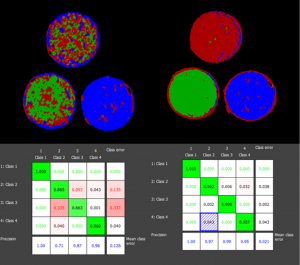Hyperspectral Imaging Basics
Spectroscopy is the study of the interaction of matter with electromagnetic radiation as a function of the frequency of the radiation. Different materials will absorb or reflect this radiation due to their chemical and physical properties, yielding a unique spectral signature. Since each material has a different spectral signature, this data not only has the potential to separate specific materials from others (qualitative spectroscopy), but also allows quantitative statements to be made on the analyzed object.
Spectrometers originally were one-dimensional point sensors, but recent spectrometers have gone from point to pixel, making spectral imaging possible and allowing us to examine the spatial distribution of chemical components, materials or quantity differences.
Imaging is the method by which an object’s form is reproduced. In spectral imaging, the method uses multiple bands across the electromagnetic spectrum to create an image from the simultaneous measurement of spectra and spatial information. The spectral bands used to create the images can either be discrete or contiguous. The use of discrete bands to create images is called multispectral Imaging, the use of contiguous bands is called hyperspectral Imaging, or just spectral imaging, and this produces an image with a very high spectral resolution.

Comparison of multispectral imaging (left) to hyperspectral imaging (right). Multispectral imaging captures a limited number of discrete wavelengths, whereas hyperspectral imaging captures a continuous spectrum.
Hyperspectral Imaging, also known as Imaging Spectroscopy, acquires simultaneous images in a high number of spectral bands, so that for each pixel of the resulting image, a continuous reflectance spectrum can be derived. The outputs of these measurements are collected in spectral datacubes and are the inputs for data processing, modeling or machine learning algorithms.
Traditionally, hyperspectral imaging has been solely about the number of spectral bands that are available for data analysis. Today, however, much more is demanded of hyperspectral imagers, including portability, flexibility, real-time data access and analysis and video spectroscopy. These features characterize the current drivers of imaging spectroscopy. Our mission at Cubert is to turn these technical properties into a successful user experience and demystify spectral products.
Hyperspectral advantage – (If quality is the driving factor?)
Since the beginning in the 1980s, hyperspectral imaging enabled the development of a whole range of narrowband indices and spectral feature fitting methods that were used for the determination of various characteristics. Those indices allow the retrieval of specific information, such as vitality status, chlorophyll content, water content, dry matter or leaf area index, just to name a few of those parameters being valuable for agriculture or forestry. Most of those indices are based on a study for a specific problem, consequently they use the whole range of different wavelengths.
However, a hyperspectral camera can perform multiples of these analyses at once, instead of focusing on one index, like NDVI, such as multispectral cameras do. This ability helps our customers perform an array of applications with the same camera.
Today, machine learning algorithms can be trained with either hyperspectral or multispectral datasets. These algorithms are designed to find the specific differences in the spectral signatures of various materials. Since hyperspectral datasets offer a much greater amount of spectral detail, machine learning algorithms benefit greatly from these hyperspectral datasets. This results in a much higher increased specificity of the classifier.

Specificity of a classification algorithm comparison between 12-band multispectral imaging (left) and 120-band hyperspectral Imaging (right). The cross-correlation matrix given for each classification shows a maximum error of 33% for the multispectral imager, whereas the hyperspectral imager has a maximum error of 4.3%.
Cubert is the only provider worldwide who delivers Hyperspectral Video Spectrometers that capture full cubes of continuous spectra in less than a millisecond
If cost is the driving factor
Hyperspectral imaging is now an indispensable tool for a growing number of applications, as well as research and development. A broad range of applications profit from the increased specificity of the wavelength discrimination of the imagers and the large amount of possible applications just one device can cover. Off-the-shelf hyperspectral imagers offer a very cost-effective solution for every application where only a small number of cameras are needed. But is there a more cost-efficient solution if the application needs dozens or hundreds of cameras?
The usual answer to this problem is to use off-the-shelf multispectral imaging cameras, due to their lower cost. But we are confident that this answer is wrong. Off-the-shelf multispectral imagers either lack the necessary spectral resolution or their available channels are at the wrong wavelength. Furthermore, the tolerances of the spectral center position, due to the complicated manufacturing process, is too high for a smooth integration of a large number of cameras into one solution.

Channel sensitivity of a multispectral imaging system. These channels cannot discriminate the spectral difference between oxygenated blood and deoxygenated blood, which is a simple task with a hyperspectral camera (see spectral comparison on the right). However, with Light Field Hyperspectral Imaging, it is possible to derive the precise position of the critical channels and provide them in a customized system, which will fit the needs of price, spatial and spectral resolution.
